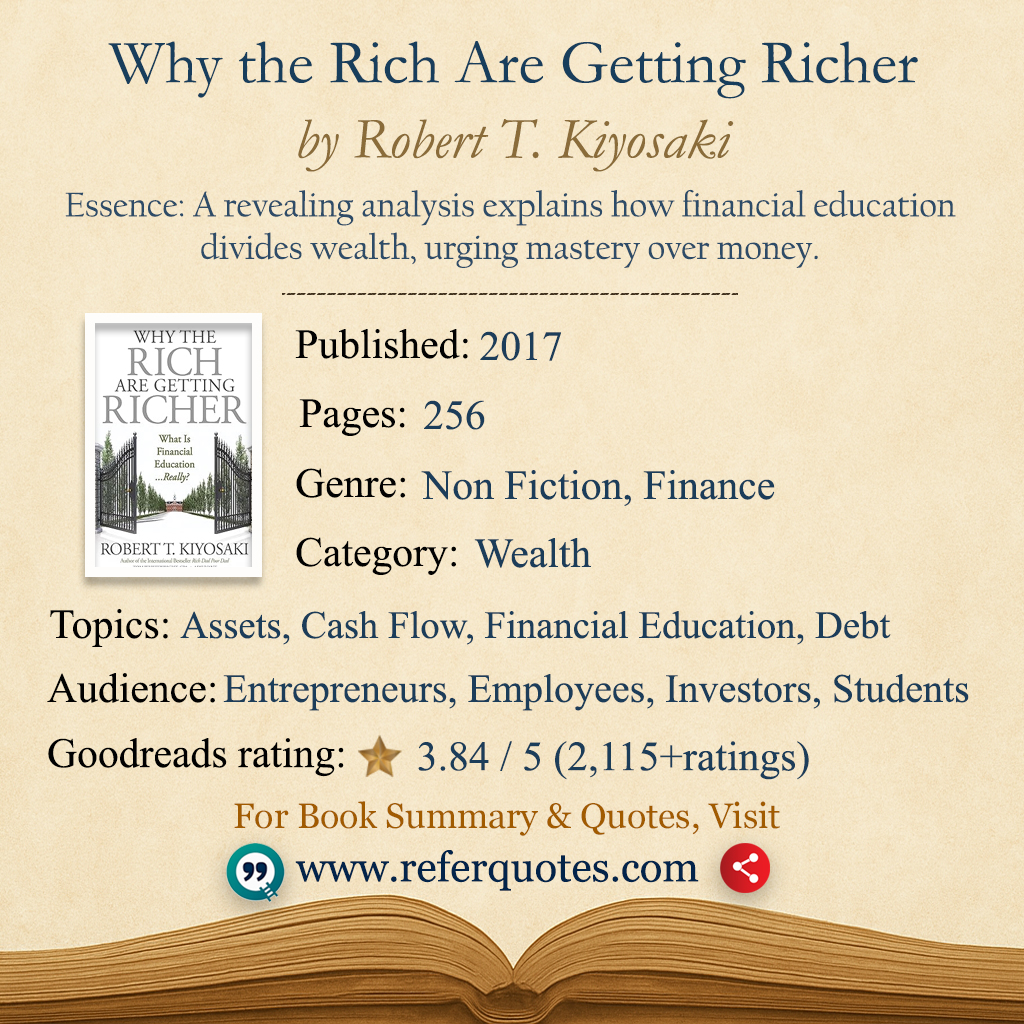- Assets buy freedom; liabilities buy stress.
- Tax, debt, and cash flow literacy separate the rich from everyone else.
Book Summary
| Language | English (277) |
|---|---|
| Published On | 2017 (4) |
| Timeperiod | 21st Century (108) |
| Genre | finance (6), nonfiction (88) |
| Category | Wealth (11) |
| Topics | assets (3), cash flow (1), debt (1), financial education (1) |
| Audiences | employees (7), entrepreneurs (87), investors (15), students (198) |
Table of Contents
- What’s Inside Why the Rich Are Getting Richer
- Book Summary
- Chapter Summary
- Why the Rich Are Getting Richer Insights
- Usage & Application
- Life Lessons
- FAQ
- Famous Quotes from Why the Rich Are Getting Richer
What’s Inside Why the Rich Are Getting Richer
Synopsis
A practical guide explaining how the rich use assets, tax advantages, leverage, and cash-flow strategies, backed by Rich Dad principles to build lasting wealth and financial independence.
Book Summary
- Wealth comes from buying assets that pay you, not income alone.
- Tax rules reward investors and business owners who understand the code.
- Good debt can accelerate wealth; bad debt drains cash flow.
- Cash-flow literacy is the core of real financial education.
- Mindset shifts drive behavior, and behavior drives net worth.
Chapter Summary
Chapter 2: Financial Education Matters – True wealth begins with learning how money really works.
Chapter 3: The Cashflow Quadrant – Moving from employee or self-employed to business owner or investor changes your financial destiny.
Chapter 4: The Power of Leverage – The rich use other people’s time, money, and knowledge to multiply results.
Chapter 5: Taxes and Debt – The wealthy understand and use tax laws and good debt to their advantage.
Chapter 6: The School System’s Failure – Traditional education trains workers, not financially free individuals.
Chapter 7: Mindset Over Money – Wealth begins with thinking differently about risk, failure, and opportunity.
Chapter 8: Building and Buying Assets – Focus on acquiring income generating assets instead of liabilities.
Chapter 9: The New Rules of Money – The digital age rewards financial intelligence, creativity, and adaptability.
Chapter 10: The Future Belongs to the Financially Educated – Those who keep learning about money will thrive, no matter how the world changes.
Why the Rich Are Getting Richer Insights
| Book Title | Why the Rich Are Getting Richer |
| Book Subtitle | What is financial education... really? |
| Author | Robert T. Kiyosaki |
| Publisher | Plata Publishing, LLC |
| Translation | Not applicable (originally published in English) |
| Details | Publication Year/Date: 2017, ISBN/Unique Identifier: 9781612680811, Last edition: 1st Edition, Number of pages: 256 |
| Goodreads Rating | 3.84 / 5 – 2,115 ratings – 236 reviews |
Usage & Application
How to Use This Book
Here’s how to put the book’s ideas to work fast.
1) Career pivot: If you’re a high-earning employee with little savings, build a 12-month plan to convert 10–20% of your income into cash-flowing assets (e.g., index funds, REITs, or a small service business). Track monthly cash flow and reinvest profits.
2) Small business owner: Use the book’s tax and entity insights to separate personal and business finances, then systemize cash flow with a weekly scorecard (revenue, expenses, net cash). Redirect surplus into assets that reduce tax while producing income.
3) Debt triage: Refinance high-interest consumer debt, then redeploy freed-up cash to buy assets with positive cash-on-cash returns. Start small, iterate monthly, and scale only what consistently pays you. The goal isn’t fancy, just predictable cash flow that compounds.
Video Book Summary
Life Lessons
- Wealth is measured in months of survivability from cash-flowing assets, not salary size.
- The tax code is a set of incentives; learn them and align your behavior accordingly.
- Leverage is neutral, used wisely, good debt multiplies asset-building.
- Financial education is practical: read statements, manage cash flow, buy assets.
- Mindset shifts precede money shifts; beliefs drive financial behavior.

